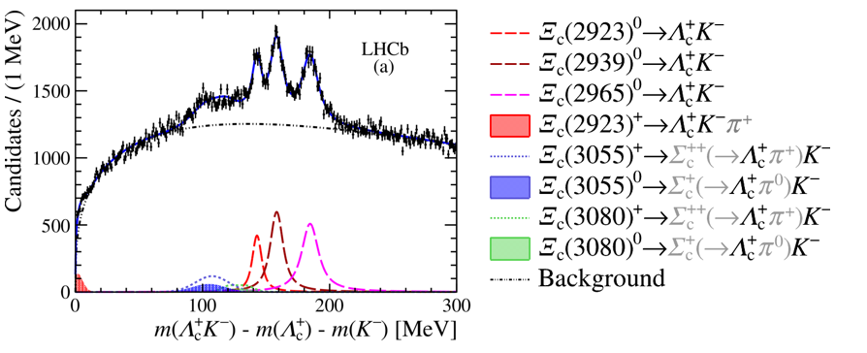Today, the LHCb collaboration submitted a paper reporting a system of three particles interpreted as three narrow excited Ξc0 – states. The Ξc0 baryon is composed of a charm-, a strange- and a down-quark (csd).
The lightest of all baryons, the proton, which is the nucleus of the hydrogen atom, is composed of two up- and one down-quark (uud) while its neutral partner the neutron is composed of two down- and one up-quark (ddu). If one (or more) light quark is replaced by either a charm c or a beauty b heavy quark we obtain heavier charmed or beauty baryon particles. The three quarks can also be formed in their lowest-energy quantum mechanical state: the ground state. Like electrons in atoms, the quarks can be rearranged into excited states with different values of angular momentum and quark spin orientation. Following particle physics tradition these excited states are called particles.
LHCb physicists searched for excited Ξc0 states in their decay into a Λc+ baryon and a K– meson. The Λc+ baryons were reconstructed in their decays into pK–π+. The image shows the distributions of the Λc+ K– invariant mass minus the Λc+ and the K– masses. Three narrow structures are clearly visible. They represent an observation, with large statistical significance, of three excited states of the Ξc0 baryon. They are named Ξc(2923)0, Ξc(2939)0 and Ξc(2965)0. The numbers in brackets represent the masses of these states as measured by LHCb.
While other excited Ξc states have been reported before, the Ξc(2923)0 and Ξc(2939)0 are observed as new narrow states for the first time. The Ξc(2965)0 seen by LHCb is close to a previously known state, the Ξc(2970)0, but its measured mass and width properties differ significantly from the average of existing Belle and BABAR results for the Ξc(2970)0. Further studies will be required to determine whether more than one state is present in the 2965-2970 MeV region, and, if so, the relation between them.
Today’s discovery of excited states of the Ξc0 baryon, together with previous discoveries of other excited states of baryons containing heavy quarks (such as excited Λb, Σb, Ωc and Ωb), will improve our knowledge of the quantum structure of charmed and beautiful baryons. Read more in the LHCb paper and in the APS Synopsis.

